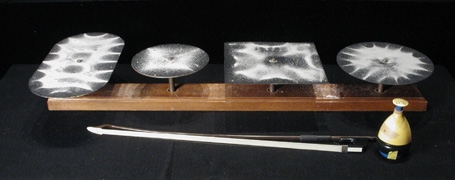Ernst Chladni is a physicist but incorporates his work into music and the use of music as vibrations to create art on a Chladni plate. A particle on the plate, sand, rocks, or in the video, couscous, will vibrate because of the friction between an object and the plate. In the video, it was a bow gliding across the edge of the plate, which made the couscous move to areas where there are limited vibrations. This process creates symmetrical patterns made with the coming together of the particles. Though the video is not an example of how digital sounds can create art, careful algorithms can create desired patterns with calculated vibrations. Every chladni plate has a different pattern because the way each plate vibrates is different. Not only is this art visually, but musically as well. The combination of both forms of art is an interesting exploration into how something that is heard can affect something that is seen.
To generate this type of pattern, the oscillation of the plate is precise, which creates the distant locations the particles will oscillate too. The symmetry and pattern can be predicted the more an object rubs against the plate. An artist can stop whenever they care to, however, the more they strike the plate, the more detailed each pattern becomes because of the longer vibrations the particles will experience. This style of art can be done by anyone and with any medium.


![[OLD FALL 2020] 15-104 • Introduction to Computing for Creative Practice](wp-content/uploads/2021/09/stop-banner.png)